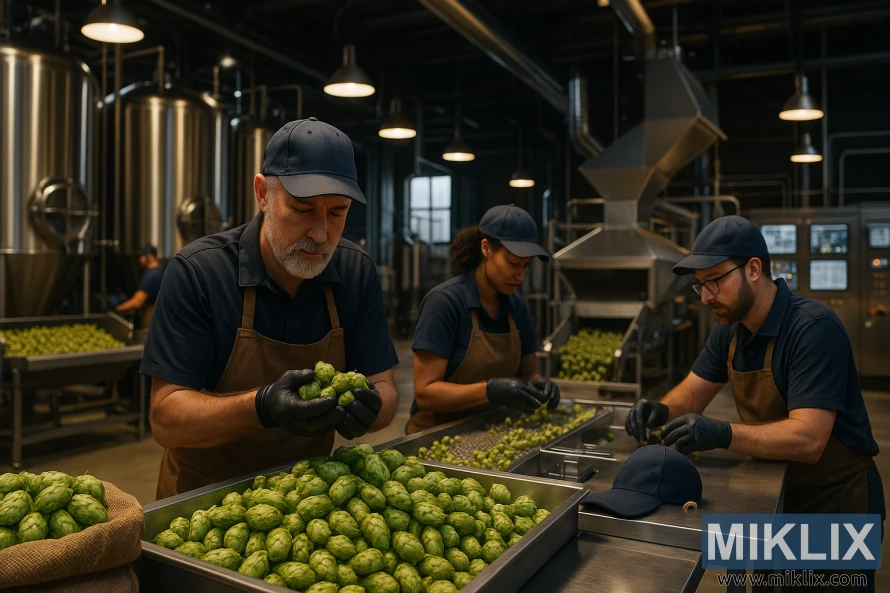Image: Modern Brewery with Columbia Hops
Published: July 25, 2025 at 7:51:32 AM UTC
Last updated: September 27, 2025 at 12:17:31 PM UTC
Brewers examine fresh Columbia hops amid drying and pelletizing equipment in a state-of-the-art brewery, blending tradition with innovation.
Inside the controlled hum of a state-of-the-art brewery, the space comes alive with the rhythmic movement of people and machines working in harmony. The foreground draws the eye to a team of dedicated brewers, their focus fixed on the task of inspecting freshly harvested Columbia hops. Each cone, vibrant green and sticky with aromatic lupulin oils, is handled with care, as if each represents not just a harvest but a promise of the beer it will one day help shape. One brewer, distinguished by his silver beard and quiet concentration, lifts a handful of cones to eye level, rotating them gently in his gloved hands to evaluate their structure, density, and resin content. His colleagues, equally absorbed in their work, sift through trays piled high with the fragrant bounty, sorting, trimming, and preparing the harvest with a meticulousness that reflects both tradition and innovation. The glisten of oils on the hops catches the warm light, evoking a sensory suggestion of pine, citrus, and earth—aromas that already hint at the character they will impart in the brew.
The middle ground of the scene transitions seamlessly into the mechanical heartbeat of the brewery’s hop processing system. Stainless steel conveyors and drying units hum steadily as they move the cones from one stage to another. Some trays feed into drying tunnels, where precise temperature and airflow preserve the delicate compounds that give Columbia hops their distinctive qualities. Other machines compress the hops into pellets, compacting their essence for more efficient storage and usage. The process is both mechanical and almost ceremonial, with the brewers overseeing every stage to ensure no compromise in quality. There is a sense of balance here: while technology accelerates and refines the work, human intuition still governs the decisions, ensuring that the character of the hops remains intact.
In the background, the sheer scale of the brewery unfolds like a modern cathedral of brewing science. Towering stainless steel fermenters rise against the industrial brick walls, their curved surfaces gleaming beneath rows of pendant lights suspended from the ceiling. High-tech control panels glow softly, their screens filled with data streams—graphs charting fermentation curves, gauges monitoring temperatures, and algorithms forecasting yields. The contrast between the organic texture of the hops and the precision of digital readouts captures the dual spirit of this place: rooted in agricultural heritage yet propelled forward by cutting-edge innovation. The soft amber glow of the lighting casts both warmth and gravity on the proceedings, underscoring the seriousness with which this work is approached.
The overall atmosphere is one of purposeful intensity, blending the reverence of tradition with the excitement of discovery. The Columbia hops at the center of the scene embody this intersection, their earthy yet floral complexity promising bold contributions to hop-forward craft beers of the future. Every action—the careful handling by skilled brewers, the efficient flow of machines, the constant monitoring of data—reflects the industry’s evolving relationship with its most vital ingredient. There is a clear recognition that hops are not simply an additive but the very soul of modern brewing, a bridge between the soil in which they are grown and the innovative beers that will delight drinkers around the world.
The image is related to: Hops in Beer Brewing: Columbia

